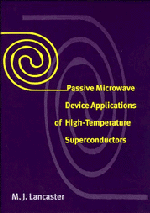Book contents
- Frontmatter
- Contents
- Preface
- Acknowledgements
- 1 Superconductivity at microwave frequencies
- 2 Superconducting transmission lines
- 3 Superconducting cavity resonators
- 4 Microwave measurements
- 5 Superconducting filters
- 6 Superconducting delay lines
- 7 Superconducting antennas
- 8 Signal processing systems
- Appendix 1 The surface impedance of HTS materials
- Appendix 2 Substrates for superconductors
- Appendix 3 Some useful relations
- Index
3 - Superconducting cavity resonators
Published online by Cambridge University Press: 14 September 2009
- Frontmatter
- Contents
- Preface
- Acknowledgements
- 1 Superconductivity at microwave frequencies
- 2 Superconducting transmission lines
- 3 Superconducting cavity resonators
- 4 Microwave measurements
- 5 Superconducting filters
- 6 Superconducting delay lines
- 7 Superconducting antennas
- 8 Signal processing systems
- Appendix 1 The surface impedance of HTS materials
- Appendix 2 Substrates for superconductors
- Appendix 3 Some useful relations
- Index
Summary
Introduction
A cavity resonator is any structure which is able to contain an oscillating electromagnetic field. In general, it has a number of distinct resonant frequencies which are dependent upon the geometry of the cavity. If an oscillating field is set up within a cavity it will gradually decay because of losses. These losses may be due to a number of phenomena but are mainly due to (i) the finite conductivity of the walls of the cavity, (ii) losses in any dielectric material within the cavity or (iii) radiation out of any apertures in the walls. The main reason for using superconductors in the construction of a cavity is to reduce the conduction loss and reduce this decay to a minimum. The decay of the oscillating field is inversely proportional to the quality factor of the cavity, and is discussed extensively below for the characterisation of cavities.
Cavities are of interest for a number of reasons. By producing a superconducting sample part of a cavity resonator the losses in the superconductor can be deduced. Cavities also form the main functional part of many microwave filters. By coupling a number of cavities together, a filter can be constructed. A high-Q cavity also forms the main feedback element in a microwave oscillator. In fact, cavity resonators form the most fundamental building block in the majority of microwave circuits and hence will be discussed in some detail in this chapter.
- Type
- Chapter
- Information
- Publisher: Cambridge University PressPrint publication year: 1997
- 1
- Cited by



